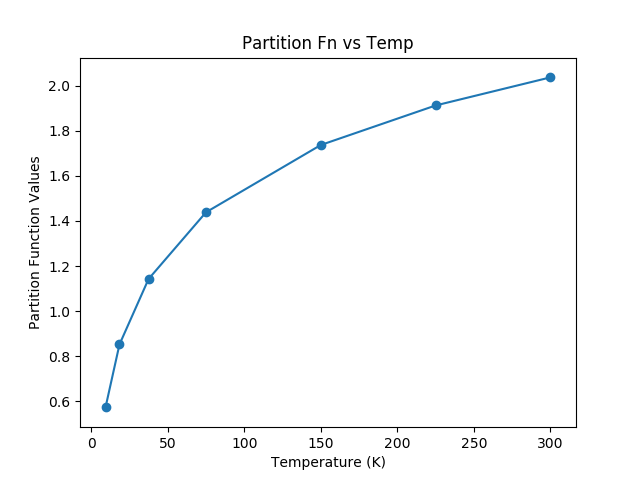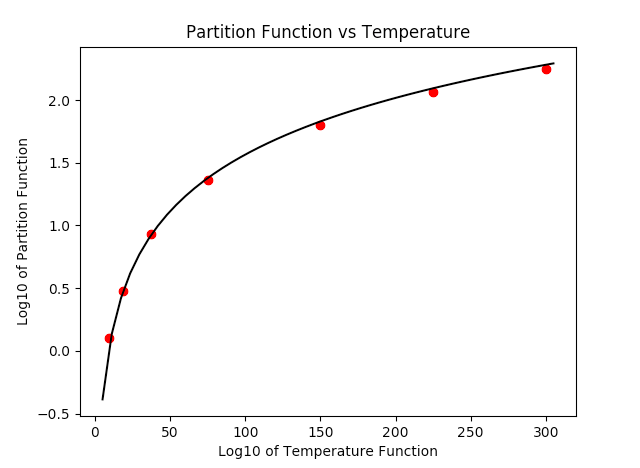JPL Spectroscopy Queries (astroquery.jplspec)¶
Getting Started¶
The JPLSpec module provides a query interface for JPL Molecular
Spectroscopy Catalog. The
module outputs the results that would arise from the browser form,
using similar search criteria as the ones found in the form, and presents
the output as a Table.
Examples¶
Querying the catalog¶
The default option to return the query payload is set to false, in the following examples we have explicitly set it to False and True to show the what each setting yields:
>>> from astroquery.jplspec import JPLSpec
>>> import astropy.units as u
>>> response = JPLSpec.query_lines(min_frequency=100 * u.GHz,
max_frequency=1000 * u.GHz,
min_strength=-500,
molecule="28001 CO",
max_lines = 7,
get_query_payload=False)
>>> print(response)
FREQ ERR LGINT DR ELO GUP TAG QNFMT QN' QN"
MHz MHz MHz nm2 1 / cm
----------- ------ ------- --- -------- --- ------ ----- --- ---
115271.2018 0.0005 -5.0105 2 0.0 3 -28001 101 1 0
345795.9899 0.0005 -3.6118 2 11.535 7 -28001 101 3 2
461040.7682 0.0005 -3.2657 2 23.0695 9 -28001 101 4 3
576267.9305 0.0005 -3.0118 2 38.4481 11 -28001 101 5 4
691473.0763 0.0005 -2.8193 2 57.6704 13 -28001 101 6 5
806651.806 0.005 -2.6716 2 80.7354 15 -28001 101 7 6
921799.7 0.005 -2.559 2 107.6424 17 -28001 101 8 7
The following example, with get_query_payload = True, returns the payload:
>>> response = JPLSpec.query_lines(min_frequency=100 * u.GHz,
max_frequency=1000 * u.GHz,
min_strength=-500,
molecule="28001 CO",
max_lines = 7,
get_query_payload=True)
>>> print(response)
{'MinNu': 100.0, 'MaxNu': 1000.0, 'Mol': '28001 CO', 'UnitNu': 'GHz',
'StrLim': -500, 'MaxLines': 7}
The units of the columns of the query can be displayed by calling
response.info:
>>> response = JPLSpec.query_lines(min_frequency=100 * u.GHz,
max_frequency=1000 * u.GHz,
min_strength=-500,
molecule="28001 CO",
max_lines = 7,
get_query_payload=True)
>>> print(response.info)
<Table length=7>
name dtype unit
----- ------- -------
FREQ float64 MHz
ERR float64 MHz
LGINT float64 MHz nm2
DR int64
ELO float64 1 / cm
GUP int64
TAG int64
QNFMT int64
QN' int64
QN" int64
These come in handy for converting to other units easily, an example using a simplified version of the data above is shown below:
>>> print (response)
FREQ ERR ELO
MHz MHz 1 / cm
----------- ------- -------
115271.2018 0.0005 0.0
345795.9899 0.0005 11.535
461040.7682 0.0005 23.0695
>>> response['FREQ'].quantity
<Quantity [115271.2018,345795.9899,461040.7682] MHz>
>>> response['FREQ'].to('GHz')
<Quantity [115.2712018,345.7959899,461.0407682] GHz>
The parameters and response keys are described in detail under the Reference/API section.
Looking Up More Information from the catdir.cat file¶
If you have found a molecule you are interested in, the TAG field in the results provides enough information to access specific molecule information such as the partition functions at different temperatures. Keep in mind that a negative TAG value signifies that the line frequency has been measured in the laboratory
>>> import matplotlib.pyplot as plt
>>> from astroquery.jplspec import JPLSpec
>>> result = JPLSpec.get_species_table()
>>> mol = result[result['TAG'] == 28001] #do not include signs of TAG for this
>>> print(mol)
TAG NAME NLINE QLOG1 QLOG2 ... QLOG5 QLOG6 QLOG7 VER
int64 str13 int64 float64 float64 ... float64 float64 float64 str2
----- ----- ----- ------- ------- ... ------- ------- ------- ----
28001 CO 91 2.0369 1.9123 ... 1.1429 0.8526 0.5733 4*
You can also access the temperature of the partition function through metadata:
>>> result['QLOG2'].meta
{'Temperature (K)' : 225}
>>> result.meta
{'Temperature (K)': [300, 225, 150, 75, 37.5, 18.5,
9.375]}
One of the advantages of using JPLSpec is the availability in the catalog of the partition function at different temperatures for the molecules. As a continuation of the example above, an example that accesses and plots the partition function against the temperatures found in the metadata is shown below:
>>> temp = result.meta['Temperature (K)']
>>> part = list(mol['QLOG1','QLOG2','QLOG3', 'QLOG4', 'QLOG5','QLOG6',
'QLOG7'][0])
>>> plt.scatter(temp,part)
>>> plt.xlabel('Temperature (K)')
>>> plt.ylabel('Partition Function Value')
>>> plt.title('Parititon Fn vs Temp')
>>> plt.show()

The resulting plot from the example above¶
For non-linear molecules like H2O, curve fitting methods can be used to
calculate production rates at different temperatures with the proportionality:
a*T**(3./2.). Calling the process above for the H2O molecule (instead of
for the CO molecule) we can continue to determine the partition function at
other temperatures using curve fitting models:
>>> from scipy.optimize import curve_fit
>>> def f(T,a):
return np.log10(a*T**(1.5))
>>> param, cov = curve_fit(f,temp,part)
>>> print(param)
# array([0.03676998])
>>> x = np.linspace(5,305)
>>> y = f(x,0.03676998)
>>> plt.scatter(temp,part,c='r')
>>> plt.plot(x,y,'k')
>>> plt.title('Partition Function vs Temperature')
>>> plt.xlabel('Temperature')
>>> plt.ylabel('Log10 of Partition Function')
>>> plt.show()

The resulting plot from the example above¶
Querying the Catalog with Regexes and Relative names¶
Although you could print the species table and see what molecules you’re
interested in, maybe you just want a general search of any H2O molecule,
or maybe you want a specific range of H2O molecules in your result. This
module allows you to enter a regular expression or string as a parameter
by adding the parameter parse_name_locally = True and returns the results
that the regex matched with by parsing through the local catalog file. It is
recommended that if you are using just the corresponding molecule number found
in the JPL query catalog or a string with the exact name found in the catalog,
that you do not set the local parse parameter since the module will be able
to query these directly.
>>> from astroquery.jplspec import JPLSpec
>>> import astropy.units as u
>>> response = JPLSpec.query_lines_async(min_frequency=100 * u.GHz,
max_frequency=1000 * u.GHz,
min_strength=-500,
molecule="H2O",
parse_name_locally=True)
Searches like these can lead to very broad queries. Since the table yields extensive results, we will only show a dictionary of the tags that went into the payload to create a response:
>>> {'CH2OO': 46014,
'H2O': 18003,
'H2O v2,2v2,v': 18005,
'H2O-17': 19003,
'H2O-18': 20003,
'H2O2': 34004,
'HCCCH2OD': 57003,
'HCCCH2OH': 56010,
'HCOCH2OH': 60006,
'NH2CH2CH2OH': 61004}
As you can see, the ‘H2O’ string was processed as a regular expression, and the search matched any molecule that contained the combination of characters ‘H20’.
A few examples that show the power of the regex option are the following:
>>> response = JPLSpec.query_lines_async(min_frequency=100 * u.GHz,
max_frequency=1000 * u.GHz,
min_strength=-500,
molecule="H2O$",
parse_name_locally=True)
The response:
>>> {'H2O': 18003}
As seen above, the regular expression “H2O$” yields only an exact match because the special character $ matches the end of the line. This functionality allows you to be as specific or vague as you want to allow the results to be:
>>> from astroquery.jplspec import JPLSpec
>>> import astropy.units as u
>>> response = JPLSpec.query_lines_async(min_frequency=100 * u.GHz,
max_frequency=1000 * u.GHz,
min_strength=-500,
molecule="^H.O$",
parse_name_locally=True)
This pattern matches any word that starts with an H, ends with an O, and contains any character in between, it results in the following molecules being queried:
>>> {'H2O': 18003,
'HDO': 19002
'HCO': 29004
'HNO': 31005 }
Another example of the functionality of this option is the option to obtain results from a molecule and its isotopes, in this case H2O and HDO:
>>> from astroquery.jplspec import JPLSpec
>>> import astropy.units as u
>>> response = JPLSpec.query_lines_async(min_frequency=100 * u.GHz,
max_frequency=1000 * u.GHz,
min_strength=-500,
molecule="^H[2D]O(-\d\d|)$",
parse_name_locally=True)
This pattern matches any H2O and HDO isotopes and it results in the following molecules being part of the payload:
>>> {'H2O': 18003,
'H2O-17': 19003,
'H2O-18': 20003,
'HDO': 19002,
'HDO-18': 21001}
Remember to print your response to see the table of your results.
Reference/API¶
astroquery.jplspec Package¶
JPL Spectral Catalog¶
- author
Giannina Guzman (gguzman2@villanova.edu)
- author
Miguel de Val-Borro (miguel.deval@gmail.com)
Classes¶
|
Configuration parameters for |